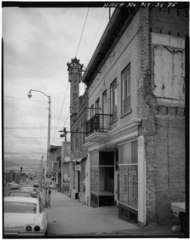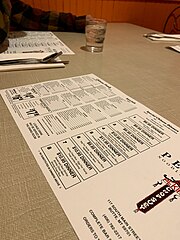Pekin Noodle Parlor
| Pekin Noodle Parlor | |
|---|---|
 Pekin Noodle Parlor in 2020 | |
 | |
| Restaurant information | |
| Established | 1911 |
| Owner(s) | Jerry Tam |
| Food type | American Chinese cuisine |
| Street address | 117 South Main Street |
| City | Butte |
| State | Montana |
| Postal/ZIP Code | 59701 |
| Country | United States |
| Coordinates | 46°00′42″N 112°32′09″W / 46.0117°N 112.5359°W |
Pekin Noodle Parlor (built 1909) is the second oldest continuously[1] operating Chinese restaurant in the United States, located in Butte, Montana. The restaurant was founded in its current location in 1911 by Hum Yow and Tam Kwong Yee.[2] Along with the Wah Chong Tai Company mercantile building (1891) and the Mai Wah Noodle Parlor (1909), the Pekin Noodle Parlor represents one of the last surviving properties from the original Chinatown neighborhood in the Butte–Anaconda Historic District.[3]
In 2023, the restaurant was named an American Classic by the James Beard Foundation.[4][5]
Background
[edit]Placer gold mining in the late 19th century brought Chinese immigrants to Butte to work the mines. However, anti-Chinese sentiment stoked by labor unions later forced the Chinese out of the mining industry.[6] They eventually settled in Uptown Butte in the 1880s, and opened businesses in a Chinatown neighborhood bordered by West Galena Street in the North, South Main Street in the East, West Mercury Street in the South, and Colorado Street in the West. "China Alley" became a thriving community which may have reached a population of 600 at its height.[7][8]
Even though attorney Wilbur F. Sanders successfully defended the Chinese people of Butte in Hum Fay, et al. v. Baldwin (also known as the Chinese Boycott Case),[6] the majority of Chinese people left Butte after labor unions organized a sustained campaign of major boycotts of Butte's Chinatown lasting many years in the late 1890s. By 1940, only 92 Chinese people remained.[7]
History
[edit]The Tam family left their home in Guangzhou and emigrated to Montana in the 1860s. The elder Tam found work shipping supplies to Chinese communities on the west coast, while his son made his way to Butte in the 1890s and founded the Quong Fong Laundry, which continued serving the community for another fifty years at its South Arizona Street location,[9] as well as a spice import and export business.[10]
Hum Yow, a Tam family relative and California-born, first-generation Chinese, originally started Pekin Noodle Parlor on West Mercury Street. It moved in 1911 to the second floor of a brick building on South Main Street near the corner of West Galena. It was built by architect G. E. DeSnell, designed for Butte attorney F. T. McBride, and completed in 1909.[6][11] Family relatives Hum Yow and Tam Kwong Yee soon established themselves as businessmen at the new location in Uptown Butte.[9]
When the restaurant first opened, "it catered to a diverse clientele of miners, theater-goers, and wealthy citizens. Then, as now, the menu featured Chinese American classics like chow mein, chop suey, and egg foo young."[12] The restaurant offered a wide variety of dishes on its menu, but customers preferred their wet noodles (yaka mein) and chop suey. Pekin Noodle Parlor also offered takeout and delivery.[13] The restaurant installed their first sign in 1916 and added neon some time later. Neon signs became popular after World War I and were used to attract customers.[13]
Ding Kuen Tam, the grandson of Tam Kwong Lee, left China and came to the U.S. in 1947.[9] He became known as Danny Wong and purchased the business from its founder, his great-uncle Hum Yow, when he retired. Wong ran the establishment for more than six decades with his wife, Sharon Chu.[14] Chu died in 2014 and Wong died in 2020. Their son Jerry Tam now runs the restaurant and has said his father's immigration story is that of the American Dream.[15]
Layout and design
[edit]Patrons enter the second floor restaurant from the ground floor on South Main Street, walking up a flight of stairs to a door on the left. The door opens into a hallway with salmon-orange colored beadboard partitions separating 17 eating rooms and booths on either side with privacy curtains for each room. The dining tables and chairs in each room date back to 1916. The central hallway is lined with Chinese lanterns hanging from the ceiling. Servers deliver food to each booth with metal carts.[8][16] The original design, for the first 50 years, was based on a light lime green color scheme with dark green velveteen curtains. It was repainted to its current orange color after the owner read an article in Bon Appetit magazine that said a "salmon color whets people's appetites".[16] The first level was at one point an herbal shop and the sub-level hosted illegal gaming.[17]
-
Restaurant exterior in 1979
-
The menu as of November 2020
References
[edit]- ^ Bartell, John (May 2024). "How a UC Davis law professor discovered the oldest Chinese restaurant in America". abc10. Retrieved 1 May 2024.
- ^ Fawcett, Kirstin (November 15, 2016). "The Delicious History of America's Oldest Chinese-American Restaurant" Archived 2020-06-17 at the Wayback Machine. Mental Floss. Retrieved June 21, 2020.
- ^ Butte--Anaconda Historic District Archived 2020-06-22 at the Wayback Machine. National Register of Historic Places. 1966.
- ^ Warerkar, Tanay (22 February 2023). "Meet the 2023 James Beard Foundation America's Classics winners". Archived from the original on 26 February 2023. Retrieved 26 February 2023.
- ^ Thornton, Tracy (2023-02-25). "Uptown Butte's Pekin Noodle Parlor earns prestigious culinary award". The Montana Standard. Archived from the original on 2023-02-25. Retrieved 2023-02-27.
- ^ a b c National Park Service. Butte-Anaconda Historic District, Montana Archived 2020-06-23 at the Wayback Machine. NPS. Retrieved June 21, 2020.
- ^ a b Schneider, Carrie (Summer, 2004). “Remembering Butte's Chinatown”. Montana: The Magazine of Western History. Montana Historical Society. 54 (2): 67-69.
- ^ a b Kentucky, Ed (January 5, 2016). "At the Pekin Noodle Parlor in Butte, history’s on the menu". KPAX. Retrieved June 21, 2020.
- ^ a b c Baucus, Max (2011). "Recognizing the Peking Noodle Parlor" Archived 2020-09-19 at the Wayback Machine. Congressional Record. USGPO. pp. 9877-9878. Retrieved June 22, 2020.
- ^ Tomky, Naomi (2023-06-09). "How the Country's Oldest Family-Owned Chinese Restaurant Has Survived for 114 Years". Thrillist. Archived from the original on 2023-06-14. Retrieved 2023-06-14.
- ^ Gibson, Richard (November 22, 2013). "Pekin Noodle Parlor (117 S Main Street)" Archived 2020-06-23 at the Wayback Machine. Butte-Anaconda National Historic Landmark District. Retrieved June 21, 2020.
- ^ Jack, Meghan E. (Spring 2020). "Exhibit Review (Chow: Making the Chinese American Restaurant)" Archived 2020-07-01 at the Wayback Machine. The Journal of American Folklore. University of Illinois Press. 133 (528): 249-251.
- ^ a b Hazlett, Kehli Kankelborg (2013)."The Foodways of Butte, Montana: Food and culture in an industrial American City" Archived 2020-06-23 at the Wayback Machine. Montana Technological University. Thesis. p. 24, 31.
- ^ Fawcett, Kirstin (November 15, 2016). "The Delicious History of America's Oldest Chinese-American Restaurant" Archived 2020-06-17 at the Wayback Machine. Mental Floss. Retrieved July 6, 2021.
- ^ John Emeigh (December 1, 2020). "Butte Pekin Noodle Parlor owner remembered for hospitality and friendliness". KXLF News. Archived from the original on July 9, 2021. Retrieved July 6, 2021.
- ^ a b McCumber, David (March 1, 2020). "A tradition of hospitality: Pekin Noodle Parlor is a James Beard semifinalist" Archived 2020-06-24 at the Wayback Machine. Montana Standard. Retrieved June 21, 2020.
- ^ Anthony Laudato and Carol Ross (November 22, 2020). "The oldest Chinese restaurant in America". CBS News. Archived from the original on July 9, 2021. Retrieved July 6, 2021.
Further reading
[edit]- Pentilla, Annie (November 26, 2016). "Butte's Pekin restaurant featured in NYC exhibit". Associated Press.
- Stern, Jane. Michael Stern (July 1994). "Butte and Beyond". Gourmet. 54 (7): p. 56.
- Trainor, Tim (July 7, 2011). "Pekin Noodle Parlor celebrates 100 today". The Montana Standard. Retrieved June 24, 2020.
- Wyckoff, William (October 1995). "Postindustrial Butte". Geographical Review. Taylor & Francis, Ltd. 85 (4): 478-496.




